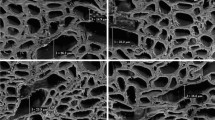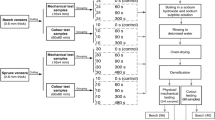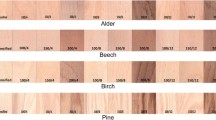Abstract
Wood veneer 700×700 mm2 specimens made with aspen (Populus tremuloides) and hybrid poplar clone 15303 (Populus maximowiczii × Populus balsamifera) were densified using heat, steam, and pressure. Temperatures of 140, 160, 180, 200, and 220°C were applied at a maximum steam pressure of 550 kPa and maximum press hydraulic pressure ranging from 4.5 to 9.0 MPa. After densification, the oven-dry density increased significantly, veneers darkened, and lathe checks that were present on veneers before densification were conglutinated and veneer surface roughness decreased. Densified veneers showed markedly reduced hygroscopicity: the higher the densification temperature, the lower the wood hygroscopicity. The Brinell hardness of densified veneer was about two to three times that of control for both aspen and hybrid poplar. Tensile and bending strength also increased significantly after densification. However, the mechanical properties of densified veneers decreased slightly with increased densification temperature. The modulus of elasticity in tension and bending increased after densification, especially at high temperatures. A very high compression set recovery was found for veneers densified at low temperatures. Recovery decreased dramatically when densification temperature exceeded 180°C. Almost no recovery was found for veneers densified at 220°C.
Zusammenfassung
Furnierprüfkörper (700 mm×700 mm) aus Espenholz (Populus tremuloides) und dem Hybridpappelklon 15303 (Populus maximowiczii × Populus balsamifera) wurden mittels Hitze, Dampf und Druck verdichtet. Die Temperaturen betrugen 140, 160, 180, 200 und 220 °C bei einem maximalen Dampfdruck von 550 kPa und einem maximalen Hydraulikdruck von 4,5 bis 9,0 MPa. Nach der Verdichtung war die Darrdichte signifikant angestiegen, die Furniere waren nachgedunkelt, vor der Verdichtung vorhandene Schälrisse waren verklebt und die Rauhigkeit der Furniere nahm ab. Die verdichteten Furniere wiesen eine merklich verringerte Hygroskopizität auf: diese war umso geringer, je höher die Verdichtungstemperatur war. Die Brinell Härte der verdichteten Furniere war sowohl bei Espe als auch bei Hybridpappel um das zwei- bis dreifache höher als die der Kontrollproben. Die Zug- und Biegefestigkeit der verdichteten Furniere ist ebenfalls signifikant angestiegen. Jedoch nahmen die mechanischen Eigenschaften der verdichteten Furniere mit zunehmender Verdichtungstemperatur leicht ab. Der Biege- und Zug-Elastizitätsmodul erhöhte sich nach der Verdichtung, insbesondere bei hohen Temperaturen. Furniere, die bei niedrigen Temperaturen verdichtet wurden, wiesen eine sehr hohe Rückverformung auf. Diese ging bei Temperaturen über 180 °C drastisch zurück. Bei 220 °C verdichtete Furniere wiesen keine Rückverformung auf.












Similar content being viewed by others
References
American Society of Testing Materials (ASTM) (1997) Standard test methods for evaluating properties of wood-base fiber and particle panel materials. ASTM D 1037-96a. Annual Book of ASTM Standards
Bao FC, Liu SQ (2001) Modeling the relationships between wood properties and quality of veneer and plywood of Chinese plantation poplars. Wood Fiber Sci 33(2):264–274
Berry SL, Roderick ML (2005) Plant-water relations and the fibre saturation point. New Phytol 168(1):25–37
Boonstra MJ, Blomberg J (2007) Semi-isostatic densification of heat-treated radiata pine. Wood Sci Technol 41(7):607–617
Borrega M, Karenlampi PP (2008) Effect of relative humidity on thermal degradation of Norway spruce (Picea abies) wood. J Wood Sci 54(4):323–328
Christensen GN, Kelsey KE (1959) Die Geschwindigkeit der Wasserdampfsorption durch Holz. Holz Roh- Werkst 17(5):178–188
Dwianto W, Morooka T, Norimoto M, Kitajima T (1999) Stress relaxation of Sugi (Cryptomeria japonica D.Don) wood in radial compression under high temperature steam. Holzforschung 53(5):541–546
EN1534 (2000) Wood and parquet flooring—determining of resistance to indentation (Brinell)–Test method. Brussels, Belgium, European Committee for Standardization
Fengel D, Wegener G (1989) Wood: chemistry, ultrastructure, reactions. de Gruyter, Berlin
Fukuta S, Asada F, Sasaki Y (2008a) The simultaneous treatment of compression drying and deformation fixation in the compression processing of wood. For Prod J 58(7–8):82–88
Fukuta S, Asada F, Sasaki Y (2008b) Influence of drilled holes on bending properties of compressed wood manufactured by new process. For Prod J 58(10):19–24
Gabrielli C, Kamke FA (2008) Treatment of chemically modified wood with VTC process to improve dimensional stability. For Prod J 58(12):82–86
Heger F, Groux M, Girardet F, Welzbacher C, Rapp AO, Navi P (2004) Mechanical and durability performance of THM-densified wood. In: Environmental optimization of wood protection workshop, Lisbon, Portugal
Higashihara T, Morooka T, Norimoto M (2000) Permanent fixation of transversely compressed wood by steaming and its mechanism. Mokuzai Gakkaishi 46(4):291–297
Inoue M, Norimoto M, Tanahashi M, Rowell RM (1993) Steam or heat fixation of compressed wood. Wood Fiber Sci 25(3):224–235
Inoue M, Sekino N, Morooka T, Rowell RM, Norimoto M (2008) Fixation of compressive deformation in wood by pre-steaming. J Trop For Sci 20(4):273–281
Ito Y, Tanahashi M, Shigematsu M, Shinoda Y (1998a) Compressive-molding of wood by high-pressure steam-treatment: Part 2. Mechanism of permanent fixation. Holzforschung 52(2):217–221
Ito Y, Tanahashi M, Shigematsu M, Shinoda Y, Ohta C (1998b) Compressive-molding of wood by high-pressure steam-treatment: Part 1. Development of compressively molded squares from thinnings. Holzforschung 52(2):211–216
Kamke FA (2006) Densified radiate pine for structural composites. Maderas, Cienc Tecnol 8(2):83–92
Kollmann FP (1936) Technologie des Holzes. Springer, Berlin
Kollmann FP, Kuenzi EW, Stamm AJ (1975) Wood based materials. Principles of wood science and technology, vol 2. Springer, Berlin
Kutnar A, Kamke FA, Sernek M (2009) Density profile and morphology of viscoelastic thermal compressed wood. Wood Sci Technol 43(1–2):57–68
Mayer I, Koch G (2007) Element content and pH value in American black cherry (Prunus serotina) with regard to colour changes during heartwood formation and hot water treatment. Wood Sci Technol 41(6):537–547
Navi P, Heger F (2004) Combined densification and thermo-hydro-mechanical processing of wood. Mater Res Soc Bull 29(5):332–336
Norimoto M, Ota C, Akitsu H, Yamada T (1993) Permanent fixation of bending deformation in wood by heat treatment. Wood Res 79:23–33
Seborg RM, Millett MA, Stamm AJ (1945) Heat-stabilized compressed wood (Staypak). Mech Eng 67(1):25–31
Sundqvist B, Karlsson O, Westermark U (2006) Determination of formic-acid and acetic acid concentrations formed during hydrothermal treatment of birch wood and its relation to colour, strength and hardness. Wood Sci Technol 40(7):549–561
Tabarsa T, Chui YH (1997) Effects of hot-pressing on properties of white spruce. For Prod J 47(5):71–76
Welzbacher CR, Wehsener J, Rapp AO, Haller P (2008) Thermo-mechanical densification combined with thermal modification of Norway spruce (Picea abies Karst) in industrial scale—dimensional stability and durability aspects. Holz Roh- Werkst 66(1):39–49
Acknowledgements
The authors wish to thank the Fonds québécois de recherche sur la nature et les technologies (FQRNT), FPInnovations and Réseau Ligniculture Québec for funding of this project. We also thank Temlam Inc. for providing aspen veneers and Réseau Ligniculture Québec and Ministère des Ressources naturelles du Québec for providing hybrid poplar veneers.
Author information
Authors and Affiliations
Corresponding author
Rights and permissions
About this article
Cite this article
Fang, CH., Mariotti, N., Cloutier, A. et al. Densification of wood veneers by compression combined with heat and steam. Eur. J. Wood Prod. 70, 155–163 (2012). https://doi.org/10.1007/s00107-011-0524-4
Received:
Published:
Issue Date:
DOI: https://doi.org/10.1007/s00107-011-0524-4




